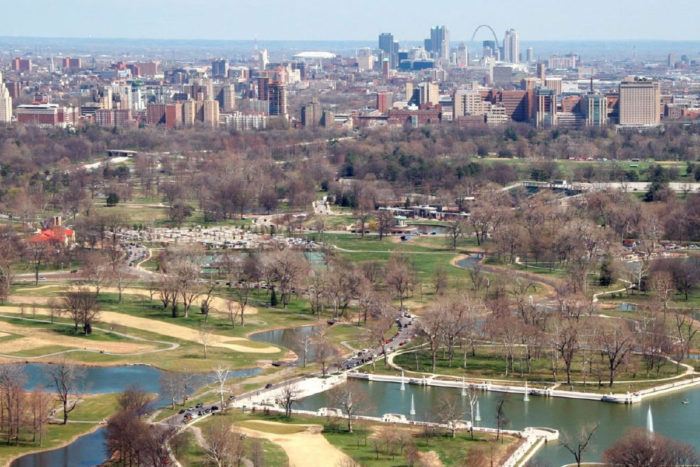WashU a partner in greenway project to connect Forest Park to the Arch
Teams interested in designing new greenway should submit qualifications by Nov. 21
 Great Rivers Greenway
Great Rivers GreenwayThe photo shows the area from Forest Park to the Gateway Arch, parts of which will become the Chouteau Greenway. Washington University is participating in a public-private partnership behind the effort.
Washington University is participating in a major public-private partnership that aims to connect Forest Park to the Gateway Arch grounds. The scenic conduit — dubbed the Chouteau Greenway — likely will stretch five to seven miles and connect neighborhoods, parks, large employers, transit, and dozens of cultural and educational institutions.
More specifically, the project will link Washington University’s Danforth Campus and Forest Park to the Washington University Medical Campus, the Cortex Innovation Community, the City Foundry STL and Armory projects, Grand Center Arts District, Saint Louis University, Harris-Stowe State University, midtown, downtown and the Gateway Arch and Mississippi riverfront.
Steering the effort is the Great Rivers Greenway, a regional public agency that works to build a network of parks and open spaces linked together by greenways. The network, supporters say, strengthens the region’s social, economic and environmental well-being and connects people to their rivers, parks and communities.
“Once finished, the greenway not only will enliven the campuses and institutions along the route, but also serve as a central spine connecting neighborhoods north and south with an amazing recreational and commuter amenity,” said Brian K. Phillips, executive director of Washington University Medical Center Redevelopment Corp. — a partnership between the School of Medicine and BJC HealthCare, and a partner in the greenway project.
“Successful cities around the world not only have great assets, they have great ways to connect those assets,” said Henry S. Webber, executive vice chancellor for administration at Washington University in St. Louis. “This project celebrates St. Louis’ many vibrant neighborhoods and great cultural and recreational assets while also doing the hard work of strengthening needed connections.”
Much of what the Chouteau Greenway will look like will be determined in an international design competition. The process will be led by architect Donald J. Stastny, who managed the design competition for the CityArchRiver project. To be considered, interested design teams are invited to submit their qualifications by Nov. 21. The competition manual can be downloaded at www.ChouteauGreenway.org.
After teams submit their qualifications, a jury of nine local and international experts will rely on a series of design goals and input from the community to evaluate each design team’s qualifications. The jury then will recommend four teams to compete. Each of the four teams will be offered a stipend to work on a conceptual design, which will be reviewed by the public and presented to the jury in late April 2018. The winning team will finalize its design by that June.
The competition invites designers to think beyond the trail itself to create active, vibrant spaces and destinations along the way. The goal is to have the greenway be a dynamic and unique St. Louis experience, similar to the High Line in New York City or the Atlanta Beltline.
“The Chouteau Greenway is envisioned to be a vibrant corridor, dense with experiential opportunities, that leverages community, institutional and private assets in creating a unique piece of urban infrastructure,” Stastny said. “As the ‘backbone’ of the central city, it will provide junctures for connections to communities, institutions and natural resources in and around the core of St. Louis.”
Jury members, chosen by the competition manager, include Maurice Cox, planning and development director for the city of Detroit; Antionette D. Carroll, founder and CEO of Creative Reaction Lab in St. Louis; Gavin Kroeber, artist and head of the Interdisciplinary Curatorial Office for The Studio for Art & Urbanism; Deborah J. Patterson, retired vice president of Global Contributions and Employee Engagement at Monsanto in St. Louis; Mark W. Johnson, founder of Civitas in Denver; Ed Hassinger, chief engineer of the Missouri Department of Transportation; Adèle Naudé Santos, professor of architecture and urban design at Massachusetts Institute of Technology; Allison Grace Williams, architect and urban designer at AGWms_studio; and alternate juror Don Roe, executive director of the city of St. Louis’ Planning and Urban Design Agency.
In addition to funding from the city of St. Louis and Great Rivers Greenway, the design competition is privately funded by Washington University in St. Louis, Washington University Medical Center Redevelopment Corp., Arch to Park Collaborative, Forest Park Forever, Grand Center Inc., Great Rivers Greenway Foundation, Green Street St. Louis, Lawrence Group and Saint Louis University. Additional stakeholder groups are forming to provide input throughout the process from a variety of agencies, businesses and organizations.
A segment of the Chouteau Greenway already is under construction and involves building a new MetroLink station at the Cortex Innovation Community. The competition and resulting conceptual design will help partners determine a plan and schedule for designing and building additional parts of the overall greenway.
 Great Rivers Greenway
Great Rivers Greenway





